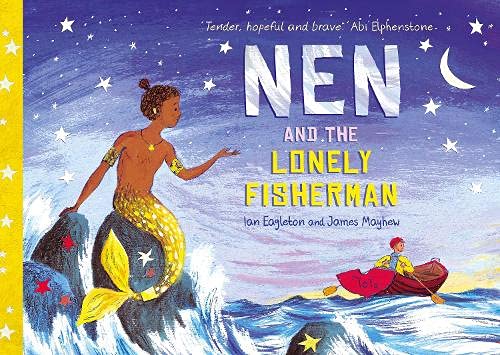Today we welcome Clare Campbell, the headteacher at St Charles RC Primary School, to talk about how she has been using NEN AND THE LONELY FISHERMAN in her school!
What a beautiful book Nen and the Lonely Fisherman is! I have found it to be suitable for all primary age groups and I have seen some amazing work on Twitter from Year 6 children and Early Years, but my focus has been with Year 2.
I first introduced them to Nen in an art lesson, I read the story to them and I asked them to draw Nen and Ernest using drawing pencils on cartridge paper, then we painted with watercolours. I modelled how to draw Nen in profile, like he is drawn on the front cover of the book. I asked the children to trace the line of their own profile, feeling the bumps and indentations, feeling down from their forehead to the bridge of their nose, tracing the shape of their lips and chin with their fingers, once they have felt their own profile, I drew Nen’s profile on the whiteboard. They each had their own individual set of watercolours and water pots. I had covered the tables beforehand, but they were very neat as they were using thin brushes. We listened to calming music and the children had a very relaxed afternoon painting, listening to the quiet music as I retold the story once again.

The next art lesson, we started with the story once again and the children were embellishing the paintings that they had made and turning them into collages. The tables were set up with oil pastels, chalk pastels, felt tips and marker pens for them to finish their original paintings in mixed media. For the collage, I set up the art resources like a sweet shop and each child had a tiny bucket to fill. They took it in turns to come up and collect their resources. They chose from tissue paper in greens and blues, silver foil, jewels, beads, sequins and tiny seashells. They all had glue and glitter glue to decorate their collages and the finished collages are gorgeous. They are all individual and different and the children really enjoyed taking ownership of their own art resources. There are no wrong answers in art, the process is just as important as the end product and although some Nen’s and Ernest’s didn’t look exactly like the ones in the book, they were their own interpretations of the characters and each one is different, unique and beautiful in its own way.


The next lesson was poetry, I always like to ask the children to write their poems on tracing paper, because then we can use images from the book, or the children’s own artwork underneath. We recapped on the story and recalled our favourite parts. Then we listened to it again, listening out for the poetic language used and we picked out favourite phrases to write on the board, such as: “The silver moon shone down on Nen’s hair and glittering salt-splashed jewels made Ernest’s eyes sparkle.” We commented on Ian’s use of alliteration in phrases like: “He searched and searched the swirling sea-waves,” “whispering waves,” “shimmering sand,” “Down, down, down, he swam into the dark depths of the ocean.” On our tracing paper we drew a line for below the water and above the water and we wrote Ernest’s poem above the water line and Nen’s below it. Some children used an acrostic style for their poems, using the letters of Ernest and Nen’s names to spell out their poem, others wrote a poem for Ernest above the waves and a poem for Nen beneath the waves. As with art, there are no right or wrong answers with poetry, it is expressive, it doesn’t need to rhyme and in the children were free to use their own imaginations and creativity to write their verses.


My Year 2 children love stories and they love writing their own books, I often make shape books for them, because they are more interesting than writing on a blank page. I made some Nen shaped books using Pacon Multicultural construction paper for Nen’s body and yellow card for his tail. I cut out the shapes beforehand, for the children to stick together and then decorate. They embellished them with gold, silver and white pens and some jewels. I reread the story with the children and asked them to retell it to their talking partner, because I feel that once they can say the story out loud, they can write it. I wrote some spellings on the board and some key phrases that the children had suggested such as: “Nen’s sad song was carried across the ocean,” “Nen’s heart was empty,” “But there was no sign of Ernest.” Then again I played some calming music as they wrote their stories on the Nen shaped books, they could choose how and where they wanted to write the story across Nen’s body and tail. The finished books were stunning and I displayed them on some sea scape backing paper.


What I have loved the most about using this stunning book with children is their interpretations of the story, their interest and their curiosity. Some children have said that Nen and Ernest are best friends, others have said that they are in love. The beautiful illustrations and fabulous imagery present educators and children with lots of ideas and it can be used as a springboard to learning for any age group.


